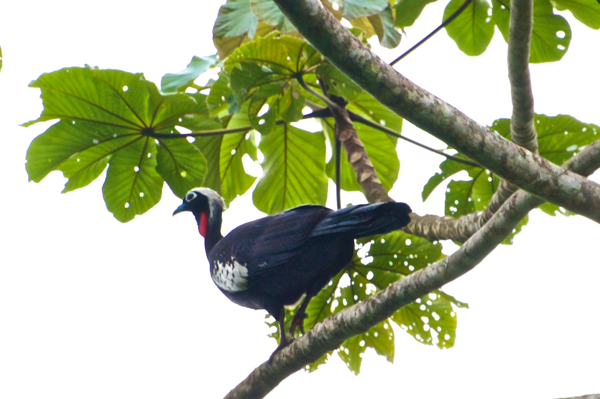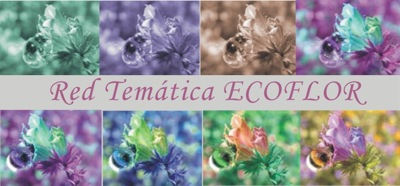
I’m just arrived from the field course in Brazil. Everything run very well and we really enjoyed this edition. Here is a photo of Aburria jacutinga in a Cecropia glazouvi tree. I’ve uploaded more photos in my FB portal.

I’m just arrived from the field course in Brazil. Everything run very well and we really enjoyed this edition. Here is a photo of Aburria jacutinga in a Cecropia glazouvi tree. I’ve uploaded more photos in my FB portal.

Fruits show an immense diversity of colors and displays. However, we are still far from a general theory for the evolution of fruit displays. The main elements of those displays do not only include color itself, but also characteristics of the fruit “design” (ow the fruit is built) like number of seeds, amount of pulp, size, etc., and the nutrients in the pulp (both macro- and micro-nutrients, as well as secondary compounds). All this adds an extraordinary complexity and diversity to the fruit displays. Together with Alfredo Valido and Martin Schaefer I’ve been exploring the evolutionary patterns of fruit traits for the Iberian Peninsula fleshy-fruited flora (ca. 120 species). We studied whether correlated trends between these elements of the display (design, nutrients, color) have been maintained through the phylogenetic diversification of the flora. We found some interesting patterns of covariation between sugar content, lipid content, and color that suggest predictable patterns of fruit evolution in relation to the main types of frugivores feeding on the fruits. Our results suggest that the evolution of fruit displays has been quite constrained by history, yet selection by frugivores might have contributed to marked and predictable covariation among color and nutrient contents. This is an interesting finding to understand the evolution of visual signals in plants, acting to attract diverse suites of animal frugivores that can act as legitimate dispersers of the seeds. Our work is now in press in Journal of Evolutionary Biology.

The long and short of it
Back from the very interesting workshop organized in Madrid by Juanjo Robledo-Arnuncio. We focussed on long-distance dispersal events (LDD) and their importance to understand the potential responses to climate change. Changes in the environment will force adaptations or long-distance migration and range expansion in plants. Thus a key question is, are the LDD services provided by animal frugivores potentially allowing this environmental tracking.
We have been advancing a lot in understanding the local, stand-level patterns of dispersal and their consequences. Yet there are numerous conceptual and methodological challenges to understand migration among patches or fragments. LDD events > 500 km will be extremely difficult to assess in a robust way with current techniques, given the tremendous logistic challenge of sampling all the potential available pollen and seed sources. However, LDD events @100 km scale are probably affordable to estimate with a combination of mechanistic models (i.e., relying on high-precision satellite tracking of animal movement combined with physiological models) and genetic tools. Large scale sequencing and cheaper DNA analysis will help to genotype massive amounts of samples and allow the identification of rare immigrants, even when migration rates are low. Some lasting conceptual challenges include the estimation of 2D dispersal kernels that accommodate the complex reality of natural landscapes and the complexities of animal movement, which is quite often markedly directional and anisotropous.
The program of this interesting and thought-provoking workshop is here:
Mini-symposium
Long distance dispersal (LDD): perspectives and new directions
December 2nd, 2010
Sala Javier Palacios
Centro de Investigación Forestal (CIFOR)
Instituto Nacional de Investigación y Tecnología Agraria y Alimentaria (INIA)
Ctra. de la Coruña km 7,5
Madrid
8h45 – 9h00. Introduction (Juanjo Robledo-Arnuncio)
9h00 – 10h00 Keynote Speaker: Prof. Ran Nathan (Univ. Jerusalem)
A movement ecology approach to study LDD of plants
10h00 – 10h50. Prof. Pedro Jordano (EBD-CSIC)
Frugivores, seeds and genes: tracking the LDD events and their consequences
10h50 – 11h20. Coffee break
11h20 – 12h10Dr. Frederic Bartumeus (CEAB-CSIC)
LDD: Seed curves, Skewness and Anomalous Diffusion
12h10 – 13h00. Prof. Miguel Ángel de Zavala (Univ. Alcalá)
Species distribution models and long-range dispersal
13h00 – 14h30. Lunch at INIA
14h30 – 15h20. Dr. Juanjo Robledo-Arnuncio (CIFOR-INIA)
Genetic estimation of LDD among plant populations
15h20 – 17h00. Open Discussion (+ coffee)
17h00. End of mini-symposium

Forthcoming talk – Dispersal near and far
An invited talk, “Frugivores, seeds and genes: tracking the LDD events and their consequences” in the workshop organized by Juanjo Robledo-Arnuncio: Long-distance dispersal: perspectives and new directions. CIFOR-INIA, Madrid.

Forthcoming papers
New papers, to be published later this year, now in press include:
– Rodríguez-Sánchez, F., Hampe, A., Jordano, P. and Arroyo, J. 2010. Past tree range dynamics in the Iberian Peninsula inferred through phylogeography and palaeodistribution modelling: A review. Review of Palaeobotany and Palynology 00: 000-000. May 2010. doi:10.1016/j.revpalbo.2010.03.008
– Verdú, M., Jordano, P. and Valiente-Banuet, A. 2010. Temporal rearrangements in the phylogenetic structure of plant facilitation networks. Journal of Ecology 00: 000-000. August 2010. [DOI: 10.1111/j.1365-2745.2010.01731.x]
– Olesen, J.M., Bascompte, J., Dupont, Y.L., Elberling, H. and Jordano, P. 2010. Missing and forbidden links in mutualistic networks. Proceedings of the Royal Society of London Series B-Biological Sciences, 00: 000-000. [doi: 10.1098/rspb.2010.1371]

The frugivory and seed dispersal meeting was organized this year in Montpellier, France. FSD2010 entitled “Frugivores and Seed Dispersal: Mechanisms and Consequences of a Key Interaction for Biodiversity”. It has been quite a success. We are preparing a ‘meeting report’ paper for Biology Letters, and the plenary talks will be published in a special issue of Acta Oecologica. I’ll update the info here…
Photo: K. Holbrook

Field Course Frugivory and Seed Dispersal, Brazil
I’ve been in Brazil again for the 7th edition of our field course “Frugivoria e Dispersão de Sementes”, co-organized with Mauro Galetti, Marco A. Pizo, and Wesley Silva. This year we run the course in Intervales Park, since Cardoso was not available due to logistic problems. It was a great success, and projects run nicely. Besides, Intervales is an impressive area.

ECOFLOR meeting in Teneriffe
The ECOFLOR meeting will be this year in Teneriffe, the 28-29 January. This is the 7th meeting of this great group of people interested in pollination biology.

Living in a defaunated world
Rodolfo Dirzo and Mauro Galetti have set up a symposium on the consequences of defaunation in tropical forests. The meeting is co-sponsored by The Center for Latin American Studies (CLAS) and the Department of Biology at Stanford University. The registration for poster presentations is still open.

Darwin in Sevilla
Together with Juan Arroyo, Encarnacion Aguilar and Teo Marañon, I’m organizing a seminar series at University of Sevilla to celebrate the 200th anniversary of Charles Darwin. For the event (25-27 Feb 2009) we have set up also an exhibit about evolution and evolutionary biology, including wonderful classic books from the University Library in relation to the subject: Linnaeus, Cuvier, Buffon, Azara, the first translations into spanish of Darwin’s books, etc. In addition we are including in the exhibit an homage to the early darwinists in Sevilla, around the figure of Antonio Machado y Nuñez, a naturalist from the late XIX century that had an enormous influence in the city and the university, and in the dissemination of evolutionary theories in Spain.

Moving to a new building
It has been a long time since my last post here… We are now in a new house: at Isla de La Cartuja. Much better in terms of functionality and space but without the lovely charm of Pabellon del Perú. We moved to the Pabellon in April 1984, so it’s been a long time there.

Kimberly arrived
Kimberly Holbrook arrived today. She will be here with a post-doc contract (Juan de la Cierva post-doc from the Spanish Minsterio de Educación), working on seed dispersal patterns of tropical species compared to temperate species. What we want to do is to assess comparatively the long-distance dispersal patterns mediated by tropical and non-tropical frugivores.

Course on measurement of colors of flowers and fruits
Together with Alfredo Valido, I gave a short and introductory course on fruit colors and their measurement. We gave that course just prior to the ECOFLOR meeting in Valencia, one of the nicest meetings we have here, where a bunch of great people working on pollination biology get together.

New paper in PLoS One
We now have our manuscript on seed dispersal by extinct megafauna accepted in PLoS One. It should come to the light by the 5th March.
Guimarães Jr, P., Galetti, M. and Jordano, P. 2008. Seed dispersal anachronisms: rethinking the fruits extinct megafauna ate. PLoS ONE.

Just arrived from Brazil
I’m just arrived from a trip to Brazil. This time Mauro is in Stanford university, so I was doing field work in Ilha de Cardoso ‘bem soazinho’, working with spatial patterns of recruitment in the palm Euterpe edulis, one of our favorite species there. In addition I went to Parque Estadual Carlos Botelho where I keep taking data on palmito regeneration. Briefly, I was aiming at characterizing the recruitment microhabitats of palmito in these two locations of Atlantic rainforest. I was using hemispherical photographs as well as direct measurements of site traits. In Cardoso I also worked with mapping of seedling, sapling, and adult spatial patterns.